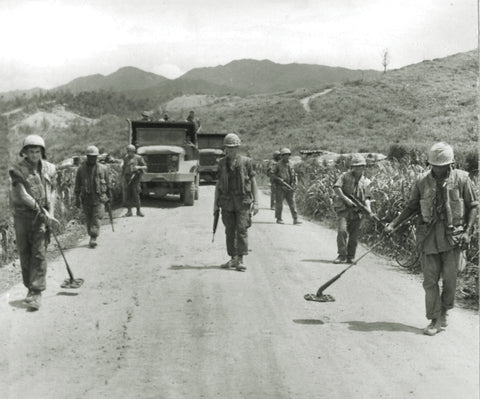
How Did Land Mine Warfare Work in Vietnam?
Land mines were used by all sides during the Vietnam War and caused significant casualties. In 1965 alone, more than one-third of U.S. Marine Corps casualties were caused by mines and explosive booby traps. A modern land mine is a concealed explosive device emplaced under, on, or even above the ground to kill or wound enemy troops, or destroy or disable vehicles.
The land mines of the Vietnam era were triggered by direct contact or command- detonated by wire. The most common contact triggers were pressure or pull (tripwire). Anti-personnel mines used a combination of blast and fragmentation effects. Most anti-vehicular mines used blast effect. Land mines are most effectively used in fixed defenses or for “area denial.” Rather than serving as a barrier to enemy movement, the purpose of a defensive minefield is to disrupt and slow an enemy’s advance and channelize him into pre-planned fields of fire and kill-zones.
Why Land Mines?
Land mines were used by both sides in contested and remote areas. The U.S. deployed millions of air-dropped small anti-personnel “button mines” as part of the McNamara Line strategy to deter NVA infiltration into South Vietnam from North Vietnam and Laos. The explosive charge in the button mines decomposed quickly. Only slightly more effective were the BLU-43/B and BLU-44/B “Dragontooth” mines. The VC made extensive use of anti-personnel mines and booby traps in likely American/ARVN assembly areas, high ground, hedgerows, tree lines, shady areas, trail junctions, and fence lines and gates.
The VC normally did not have enough material to mine an entire fence line. U.S. troops quickly learned to bypass the gates and batter down the fence at some distance from the gate. Yet all too often a later patrol would assume that an already battered-down section of the fence was clear.
The VC, however, were highly disciplined about keeping their mines under surveillance. As soon as one patrol passed through a cleared area, the VC would move in and mine the gap. The VC were methodical about marking their mines so that their troops or local villagers would not walk into them. The markers were cleverly concealed, but known to locals. American and South Vietnamese patrols generally tried to secure cooperation of one or more locals before initiating an area sweep. That was not easy. Villagers might be VC sympathizers or intimidated by other sympathizers who would hold them accountable later.
this article first appeared in vietnam magazine
Types of Land Mines
Command-detonated anti-personnel directional mines were widely used. The U.S. M-18 “Claymore” mine blasted 700 steel balls in a 60-degree arc, 6-feet high, out to a range of about 150 feet. The Claymore was triggered by an electrical blasting cap via a wire with a hand generator.
The VC used any Claymore they captured. The VC and NVA were also supplied with the Chinese-made DH-10 Directional Mine, known as the “ChiCom Claymore.” Crudely made but larger and more powerful than the U.S. M-18, it was devastatingly effective when emplaced in a tree, pointed down a jungle trail. The VC also used the DH-10 to mine anticipated helicopter landing zones.
The standard U.S. anti-personnel mines were the M-14 and M-16. Called the “Toe Popper,” the M-14 was a pressure-triggered blast mine with a relatively small charge. The M-16 was a fragmentation mine designed after the World War II German S-mine, called a “Bouncing Betty.” When triggered, either by stepping on one of the exposed pressure prongs or pulling a tripwire, a short delay fuze detonated a secondary charge which blew the main body of the mine 5 to 6 feet into the air. A second, slightly longer-delayed fuze then detonated the main charge, spraying fragmentation out to 25 meters.
An Enduring Menace
Anti-vehicular mines were used to destroy or disable trucks, armored personnel carriers, and sometimes tanks. They were either pressure- or command-detonated by wire. Road-clearing became an almost daily ritual, especially around major bases. Sweep teams of combat engineers with mine detectors worked the roads each morning, while flank security teams screened both sides of the roads looking for evidence of digging, detonating wires, and even ambushes. It was slow and tedious.
Although North Vietnam manufactured mines and some were supplied by China, the majority of mines used by communist forces in Vietnam were improvised. Enemy forces in Vietnam were exceptionally innovative at turning anything into a mine—including captured or unexploded ordnance such as hand grenades and mortar and artillery shells; ammunition cans; oil drums; beer and soda cans; and even bicycle frames. Triggering devices included flashlight batteries, wristwatches, field telephone hand cranks, and mousetraps.
This story appeared in the 2024 Winter issue of Vietnam magazine.
historynet magazines
Our 9 best-selling history titles feature in-depth storytelling and iconic imagery to engage and inform on the people, the wars, and the events that shaped America and the world.
